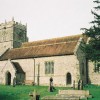“Carved by time out of a single stone” was how Thomas Hardy described Portland. Yet all of Purbeck can be regarded as a geologist’s bonanza, a chronicle of millions of years of the earth’s history set in stone. Small wonder then, that this “county within a county” should have become one of the country’s major centres for the quarrying and mining of aggregate and building stone.
The stone industry of Purbeck has been the economic mainstay of the ‘Isle’ for over 500 years. For Britain, and for the Empire through export, it has been a font of supply for several kinds of rock belonging to the Portland and Purbeck Beds. All these are part of the two uppermost-and youngest-formations of the Jurassic period, deposited between about 150 and 135 million years ago, when Dorset was sub-equatorial. The Portlandian was laid down in shallow, warm sea, which then regressed to leave a lagoon environment in which the Purbeck beds were then formed.
Although prehistoric man probably carried out very local quarrying for the stone, it was the Romans, particularly favouring the use of the decorative Purbeck Marble for their villas and tomb slabs, who first began quarrying on any significant scale. In ‘modern’ times the industry really took off during the Middle Ages; in the 17th century, too, stone was shipped from Swanage to London, where Wren employed it in re-building the capital after the Great Fire in 1666.
During the 18th and 19th centuries the Purbeck quarries reached their peak in manpower and production. It was at this time when a variety of stone used to build many of Dorset’s older cottages and homes was extracted from small local quarries now long since abandoned and overgrown. Sine transporting the stone overland was difficult and costly, the major quarries and mines were concentrated upon the coastal outcrops, where the stone could be transported away by sea.
As a focus for quarrying, nowhere else in Purbeck was more central or important than Swanage. This town became a centre for the mediaeval trade in limestone, where serious quarrying began in about 1700 and continued until the mid 19th century. This was the heyday of great stone barons, the businessmen who made their fortunes from the industry, George Burt, and John Mowlem being probably the prime movers. Swanage was built from stone in more ways than one; exports from the quarries secured its location and the prosperity of the Burt and Mowlem families. It was during this period too, that the quarry platforms in the cliff outcrops at Tilly Whim, Dancing Ledge, Winspit and Seacombe were cut.
Tilly Whim, Dancing Ledge and Winspit are all coastal quarry sites for Purbeck stone which has been used in a number of Buildings including Durlston Castle, Lulworth Castle and Swanage Town Hall. The Tilly Whim Caves at Anvil Point are the most easterly of the coastal quarries and are thought to have originally been open-cast working which later shifted towards adit or drift-mining from galleries cut into the cliffside. A capping rock was blasted away so that the high-grade building stone, the Under Freestone, could be quarried out using wedges called “gads.” Galleries of about 3 metres by 8 metres were cut into the hillside, sometimes as far as 60 metres. To support the roof, quarrymen left pillars in the in-situ limestone or else built pillars from stone wasters. Blocks were lowered from the caves using timber derricks (whims) that loaded the stone onto lighters or barges which then trans-shipped the stone to an offshore cargo vessel in calm weather.
Similarly at Dancing Ledge Quarry, the stone was lowered to a large sloping ledge, and carried to a shipment point at the very edge. Here the trammels or ruts made by the carts or wagons, which moved the stone, can still be seen. Quarrying at Dancing Ledge ceased in 1914. Winspit is an area just below Worth Matravers on the south coast where large cliffside quarries have been opened on both sides of the valley. Stone working at Winspit began in 1719. The west quarry has a very large underground gallery, which was worked until 1953; the east quarry has square cut holes for crane positions still to be seen on the cliff top.
Seacombe is a large quarry excavated where Seacombe Bottom meets the coast. This was worked from the 18th century until 1923-31, when much investment in mechanisation took place. Stone was shipped from below the west end, and the foundations of the steam-derrick remain. Other quarries were opened between Durlstone Head and St. Aldhelm’s Head, from where the stone for the harbour walling at Ramsgate was shipped. At Durlstone, deeper beds were worked from underground “quarrs,” the stone being brought to the surface by a horse drawn capstan. There are also shallow quarrs in the country-park. In 1897 197 men were working in 58 quarrs. The last timber derrick to survive anywhere in Dorset can be seen at St. Aldhelm’s Quarry.
Away from the coast there have been extensive quarries in other Purbeck Beds outcropping over the high ground between Swanage and Worth Matravers, though Lychett Matravers to Acton. Purbeck Limestone is worked for aggregate in Swanworth Quarry (due for imminent closure) and Purbeck stone is still quarried in the Acton area west of Swanage, where the rock was formerly mined from underground shafts. Today good decorative stone is being extracted at Acton from open cast pits down to 10 metres. Corfe was formerly the centre for the quarrying of Purbeck Marble (which is not true marble but shelly limestone able to take a hard polish), but the trade no longer exists today.
While the stone native to the mainland has been of considerable commercial value, Portland’s limestone has probably been even more so, and not wholly for its infra-structural applications. This oolithic limestone has encased the gargantuan shells of Titanities, the largest ammonite to have inhabited British Jurassic waters, and which today is to be seen displayed in many of Portland’s garden walls. For centuries, man and nature have contributed to the island’s landscape, and there are features marking where the original landscape once stood.
Wren used Portland stone in the re-building of London, notably the new St. Paul’s, but it has also been applied in the re-construction of the capital after the destruction left by the last war. The old quarry gangs and their methods have almost entirely disappeared. The piers and jetties of the old quarries, from where stone has been shipped around the world, also have largely vanished, and some of the excavations have been infield; no derrick or crane now remains in the Portland Quarry. In Jordan Quarry the succession in the Portland Beds can be traced up to the overlying Purbeck in a sequence which the geologist can read like a book, and which reveals the climatic changes in the region 150 million years ago.
But today some of the Portland quarries have been given a new lease of life. Through a 1983 initiative begun by the specially formed Portland Sculpture Quarry Trust (PSQT) artists and sculptors have been coming to Portland to work creatively in response to the quarry environment. The Trust aims to forge links between the artists and the lives of the masons working in stone, enabling them to share and exchange knowledge and skills, rather than undertaking public commissions for works. This project has fostered much working collaboration over the years, including the creation of Britain’s first Sculpture Quarry in the now regenerated Tout Quarry. Works produced here include Anthony Gormley’s ‘Still Falling.’ and ‘Falling Fossil’ by Stephen Marsden. PSQT is further extending access through workshops. Since 1983 the experience of the Trust has been as appreciation of the importance of the personal aspects of people’s lives and their relationship to the landscape.
Happily, after decades of decline in Portland and Purbeck, something of the old landscape is making a comeback. Abandoned quarries and older sites are being restored to their pre-extractive agricultural state, often with no trace of the former activity in evidence. While the industrial landscape on Portland is being revitalised, in Purbeck nature is re-claiming the traces of an industry, which ranged from prehistoric bell-pits, through opencast excavations and thence gallery mining, to mechanisation and decline.



